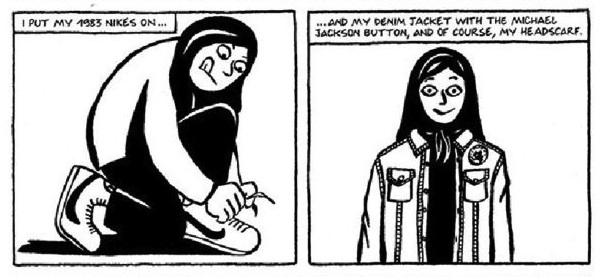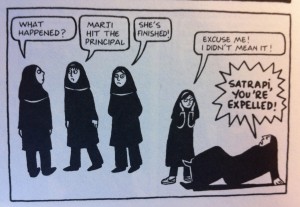For the past two weeks in ASTU class, we have been studying Marjane Satrapi’s Persepolis, which is a graphic novel about Satrapi’s growing up in the Iranian Revolution. Inspired by the discussion in our recent sociology lectures about cultures, and in particular material culture, which is the physical evidence and objects that belong to a specific culture (Ritzer and Guppy, 120), I wanted to explore the presentation of material culture and cultural contrasts in Persepolis.
I found that in Persepolis, the veil is one of the most prominent objects that represents the Iranian culture. In the 1980s, the leaders of the Islamic revolution made it mandatory for all women to wear a veil (Satrapi, 3). The opening frames of the novel, which portrays a group of girls who are covered in veil, immediately depicts the importance of the veil in revolutionary Iran. The veil becomes a part of the social values and norms, and shows the political ideology in Iran. However, for Satrapi, the veil symbolizes something different, and they could be repression, a loss of identity, and a possible need for a revolution.

The western culture is also presented in Persepolis through materials such as rock band posters in Satrapi’s room and Satrapi’s clothing. Satrapi also visits ‘black markets’, where people sell western commodities like audiotapes (Satrapi, 131-2). The presentation of Western culture shows the how influential cultures can be. It allows Satrapi to really show her personal identity, which is the western political and social beliefs she and her family holds.
How does Satrapi adapt to the two contrasting cultures? In this scene, Satrapi embraces both cultures. She wears her denim jacket with a Michael Jackson button and Nike, and says ‘of course, my headscarf’. This displays Satrapi’s multiple personal identities: following middle eastern customs while sharing western values.

The clash of western and middle eastern culture, however, also serves as a catalyst to Satrapi’s rebellion. As a child, Satrapi often refuses to follow customs and school rules. This is shown in the beginning of the last chapter of the book: ‘The Dowry’, in which the school principal tries to take Satrapi’s jewelry away, Satrapi accidentally pushes the principle to the floor, and the principle expels her. This scene is significant because it shows how Satrapi assures her personal identity by rebelling against traditions and rules.
As mentioned in my previous blog post, understanding cultures allows readers to read life narratives more carefully and critically. The cultural differences in Persepolis is powerful in showing Satrapi’s personal identities and thoughts, which makes the novel engaging. I am interested in knowing about your opinions on how culture is presented in Persepolis, or in other forms of life narratives. Leave your thoughts in the comment section below!
—-
Work cited:
Ritzer, George, and Neil Guppy. “Cultures.” Introduction to sociology. Canadian version. ed. London: SAGE, 2013. 120. Print.
Satrapi, Marjane. Persepolis. New York, NY: Pantheon Books, 2003. Print.
“Meanings of the Veil: Representations of Veiling in Persepolis.” Serendip Studio. mpottash., 13 Nov. 2008. Web. 18 Oct. 2014. <http://serendip.brynmawr.edu/exchange/node/3331>
Tinmanee, Elle. “Chapter 17: “Kim Wilde” by Elle Tinmanee.” Persepolis. N.p., 22 Mar. 2013. Web. 21 Oct. 2014. <http://ibpersepolis.wordpress.com/2013/03/22/chapter-17-kim-wilde-by-elle-tinmanee/>.
